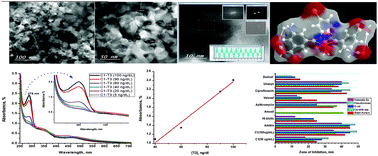当前位置:
X-MOL 学术
›
Dalton Trans.
›
论文详情
Our official English website, www.x-mol.net, welcomes your feedback! (Note: you will need to create a separate account there.)
Simple synthesis of novel copper metal–organic framework nanoparticles: biosensing and biological applications†
Dalton Transactions ( IF 4 ) Pub Date : 2018-03-15 00:00:00 , DOI: 10.1039/c8dt00371h Sheta M. Sheta 1, 2, 3, 4 , Said M. El-Sheikh 4, 5, 6, 7 , Mohkles M. Abd-Elzaher 1, 2, 3, 4
Dalton Transactions ( IF 4 ) Pub Date : 2018-03-15 00:00:00 , DOI: 10.1039/c8dt00371h Sheta M. Sheta 1, 2, 3, 4 , Said M. El-Sheikh 4, 5, 6, 7 , Mohkles M. Abd-Elzaher 1, 2, 3, 4
Affiliation

|
Novel copper metal organic framework nanoparticles Cu-MOF-NPs (C1) were prepared via two simple alternative methods and confirmed by analytical characterization using mass, IR, Raman, XRD spectrum, HR-TEM and TGA-DSC. Mass spectroscopy revealed the molecular ion peak at 647 m/z for the monomeric unit structure n[Cu(AIP)2(PIY)(H2O)2]·4H2O, the presence of which was further supported by mass fragmentation. The Raman spectrum revealed two separate peaks corresponding to D and G bands of carbon in the structure of C1. Moreover, TGA-DSC showed the presence of CuO. XRD data were typically consistent with Raman and TGA-DSC data. In addition, HR-TEM revealed that the morphology of the C1 nanoparticles is uniform with well-distributed elliptical/spherical particles with a size range from 7 to 19 nm. The spectrophotometric and biological activity studies based on Cu-MOF-NPs were analyzed. The results indicated that Cu-MOF-NPs (C1) were successfully used as biosensors for the assessment of the triiodothyronine hormone (T3). The calibration plot was achieved over the concentration range of 40.0–100.0 ng dl−1 T3 with limits of detection (LOD) and quantitation (LOQ) of 1.46 and 4.85 ng dl−1, respectively, and a correlation coefficient (r) of 0.973. Moreover, the Cu-MOF-NPs (C1) show more enhanced biological activity against various pathogens (five strains of bacteria: Gram positive and Gram negative) when compared to an antibacterial agent and the effectiveness of Cu-MOF-NPs increases with increasing particle dose. The interactions of MOF-NPs (C1) with the biological targets were studied.
中文翻译:

新型铜金属-有机骨架纳米粒子的简单合成:生物传感和生物学应用†
通过两种简单的替代方法制备了新型铜金属有机骨架纳米粒子Cu-MOF-NPs(C1),并通过质量,IR,拉曼,XRD光谱,HR-TEM和TGA-DSC的分析表征得到了证实。质谱显示单体单元结构n [Cu(AIP)2(PIY)(H 2 O)2 ]·4H 2 O的分子离子峰在647 m / z处,其存在进一步受到质量裂解的支持。拉曼光谱揭示了两个独立的峰,分别对应于C1结构中碳的D和G谱带。此外,TGA-DSC显示出CuO的存在。XRD数据通常与拉曼和TGA-DSC数据一致。此外,HR-TEM显示,C1纳米粒子的形态是均匀的,椭圆形/球形粒子分布均匀,尺寸范围为7至19 nm。分析了基于Cu-MOF-NPs的分光光度法和生物活性研究。结果表明,Cu-MOF-NPs(C1)已成功用作生物传感器,用于评估三碘甲状腺素(T3)。在40.0–100.0 ng dl -1 T3的浓度范围内获得标定图,检测限(LOD)和定量限(LOQ)分别为1.46和4.85 ng dl -1,相关系数(r)的0.973。此外,与抗菌剂相比,Cu-MOF-NPs(C1)对各种病原体(五种细菌:革兰氏阳性和革兰氏阴性)显示出更高的生物活性,并且Cu-MOF-NPs的有效性随着颗粒的增加而增加。剂量。研究了MOF-NPs(C1)与生物学靶标的相互作用。
更新日期:2018-03-15
中文翻译:

新型铜金属-有机骨架纳米粒子的简单合成:生物传感和生物学应用†
通过两种简单的替代方法制备了新型铜金属有机骨架纳米粒子Cu-MOF-NPs(C1),并通过质量,IR,拉曼,XRD光谱,HR-TEM和TGA-DSC的分析表征得到了证实。质谱显示单体单元结构n [Cu(AIP)2(PIY)(H 2 O)2 ]·4H 2 O的分子离子峰在647 m / z处,其存在进一步受到质量裂解的支持。拉曼光谱揭示了两个独立的峰,分别对应于C1结构中碳的D和G谱带。此外,TGA-DSC显示出CuO的存在。XRD数据通常与拉曼和TGA-DSC数据一致。此外,HR-TEM显示,C1纳米粒子的形态是均匀的,椭圆形/球形粒子分布均匀,尺寸范围为7至19 nm。分析了基于Cu-MOF-NPs的分光光度法和生物活性研究。结果表明,Cu-MOF-NPs(C1)已成功用作生物传感器,用于评估三碘甲状腺素(T3)。在40.0–100.0 ng dl -1 T3的浓度范围内获得标定图,检测限(LOD)和定量限(LOQ)分别为1.46和4.85 ng dl -1,相关系数(r)的0.973。此外,与抗菌剂相比,Cu-MOF-NPs(C1)对各种病原体(五种细菌:革兰氏阳性和革兰氏阴性)显示出更高的生物活性,并且Cu-MOF-NPs的有效性随着颗粒的增加而增加。剂量。研究了MOF-NPs(C1)与生物学靶标的相互作用。



























 京公网安备 11010802027423号
京公网安备 11010802027423号